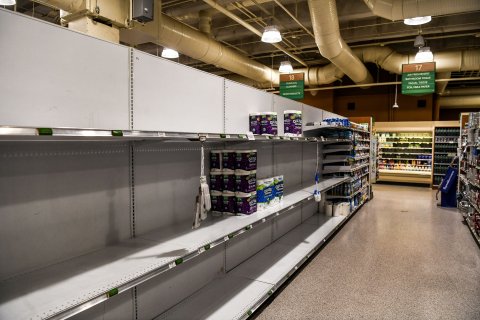Early this January after a long search, Laura Kastner, a 27-year-old consultant living in New York City, found her dream couch: a plush, Joybird brand L-shaped sectional. "It gave me butterflies when I pictured myself laying on it." She ordered it on January 3 and was told it would be delivered in six weeks. It wasn't. Now, it's due on March 16th. The reason? "We are working through delays," the company told her.
A lot of Americans have been having similar experiences lately. "A sofa is a good microcosm of how everything in the supply chain is impacted," according to Mark Schumacher, CEO of the Home Furnishings Association. "It's called a supply chain for a reason. What we have found is that it's not been a weakness or a single broken link, it's been many."
The last few months have made the phrase "supply chain" part of everyday language. According to an Oracle survey, 45 percent of Americans say that before the pandemic, they never thought about how products were delivered. Now, 87 percent say they have been negatively impacted by supply chain issues, with 60 percent unable to buy items due to shortages and 51 percent canceling orders because of delays.
A lot of forces have combined to stress supply chains starting with COVID-19–related shutdowns by manufacturers and shippers. Those pressures revealed weaknesses in the way goods are made and delivered that long predate the pandemic.
One stress point is at the beginning of the chain: An estimated 40 percent of the world's furniture, for instance, is made in China. Similarly, a single Taiwanese company makes most of the world's most sophisticated computer chips as well as many of the more common varieties. Supply for both furniture and chips haven't kept pace with rising demand. Nintendo, for instance, cut projections for sales of its popular Switch device because it couldn't get enough chips in time for the Christmas sales season.

Meanwhile furniture makers, like manufacturers of all kinds, have been hit by the fallout from the chip shortage, too. Joybird co-founder and vice president of supply chain Joshua Stellin says many things in the company's factories nowadays rely on chips—fork lifts, for instance—and the time it takes to get new or replacement equipment has slowed dramatically. "Things that used to take days and weeks now take weeks and months," he says.
There is no quick fix. Professor Morris Cohen of the Wharton School of Business says, "To build a staff at the factories that fabricate the chips takes about a year, and then it takes another year to tune it and get it to work and have acceptable yields and quality. You can't just flip a switch."
Further down the supply chain, there have been other headaches. Last year's winter storms in Texas, for instance, decimated the foam industry, a critical component for automobile and furniture manufacturers. Meanwhile, "The Great Resignation" has left shipping and trucking companies shorthanded.
"We didn't catch a break anywhere," Schumacher says. "Every aspect of the supply chain has had a hiccup of one sort or another"
Through all of this, however, consumer demand for all kinds of products has remained strong. Joybird's Stellin says the rise of work from home propelled a boom in furniture demand that quickly outpaced the company's ability to provide new product. He puts it this way: "If you look at it in terms of having a bulldozer dumping things in, and then you have a bulldozer scooping things out, [the supply] bulldozer was broken and [the demand bulldozer] was kicking ass." Joybird outsources parts from southeast Asia and manufactures mostly in Tijuana. Parts and labor shortages abroad hit Joybird's partner factories just as furniture demand began to take off.
Even when factories could turn out new couches, those goods often wound up stuck in ports due to labor shortages there. While ships once arrived and unloaded cargo within three to four days, Stellin says, that number looks more like 35–40 now, and even that "is a flip of the coin," with some delays as long as 90 days.
HFA's Schumacher says shipping has become more expensive even as it has slowed down: "We have been screaming from the rooftops as an industry since the middle of 2020 about inflation. With all these shortages, container prices, which are controlled by companies that are not American companies, have exploded." In some cases, he says, container prices are 1,000 percent higher than they were pre-pandemic.
Delays and rising prices along the supply chain have affected consumer habits. As HFA's Schumacher puts it, "We now live in a retail world where 'available in stock' is everything."
Told they'll have to wait nine months for a product they want, he says, many consumers are likely to switch to something they can get faster instead. "I want it sooner than nine months, and this is close, so I'm going to go for it," he says. Joybird's Stellin agrees, saying some furniture designs that weren't that popular have been moving quickly mainly because they are in stock in U.S. warehouses. He says consumers are likely to get products quicker if they opt for standard models rather than look for custom features.

While supply chain issues aren't going away, Wharton's Morris is optimistic about companies' growing ability to adjust. For example, toilet paper shortages have generally turned out to be short-lived. "The consumption of toilet paper didn't change because of the pandemic," he says. People weren't using more; they were using more at home, instead of at school or work. Makers responded by repackaging rolls made for institutional customers and putting them on supermarket shelves.
Morris adds, however, that kind of fix is easier in some industries than others. Longer term structural adjustments, like restoring supplies and redesigning products to use more standardized parts, will take more time and money.
HFA's Schumacher is also hopeful that the second half of the year will bring down wait times for products, though probably not back to pre-pandemic standards. "This is the year we're going to see a lot of adjustments to these crazy situations we've seen in 2020 and 2021," he says.
This story is part of a series exploring the latest consumer trends and innovations. For more articles on these topics, go to newsweek.com/oracle.










